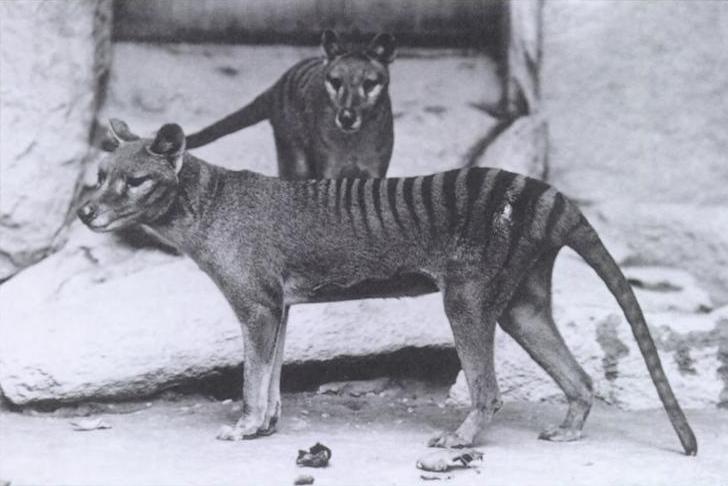The thylacine, also known as the Tasmanian tiger or Tasmanian wolf, was a large carnivorous marsupial that wasn’t related to tigers or wolves. It was the only known member of its scientific family to survive to modern times, but hasn’t been seen in the wild for decades. The last reliable sighting of a wild thylacine is from 1933.
But now, scientists want to bring the species back from extinction.
Genetic engineering company Colossal Laboratories and Biosciences company has partnered with scientists at The University of Melbourne who are developing technologies that could bring back the carnivorous marsupial.
The last-known member of the species died in its cage at the Beaumaris Zoo in Hobart, Tasmania, in 1936. Benjamin is shown in this footage from 1935, released by the National Film and Sound Archive of Australia.
Along with $5 million in private donations announced earlier this year, Colossal will invest $10 million in the research, allowing a team of about 50 scientists across Melbourne and Texas to work on the project.
The striped carnivores hunted birds, small rodents and kangaroos. But in the 1800s and early 1900s, European colonizers considered them pests. Government bounties encouraged settlers to kill thylacines, and Tasmanian tigers may also have suffered from competition with animals such as dingoes.
In 2017, research from University of Melbourne biosciences professor Andrew Pask found that thylacines also suffered from a lack of genetic diversity.
“We have now sequenced many thylacine specimens and hope to continue doing so in this new partnership with Colossal,” Pask said in an email to NPR. “Even species with low genetic diversity can be brought back to healthy population numbers again if they are managed correctly.”
The dog-like animal would be brought back using reproductive technologies specific to marsupials. Stem cells would be used to make embryos, and artificial wombs would have to be constructed. But the process would not happen quickly.
“I think we are looking at a decade or so to get the animal back. Then, for most re-wilding efforts of this scope, you would want to very closely study the animal in large captive areas on Tasmania to make sure it is fitting back into the ecosystem before releasing them across the whole island. This would take potentially another 10 years to be sure we are doing this as carefully as possible,” Pask told CBS, adding that the technologies used could be applied to many other species to protect the world from further loss of biodiversity.

Other experts are less optimistic.
“De-extinction is a fairytale science,” associate professor Jeremy Austin from the Australian Centre for Ancient DNA told the Sydney Morning Herald. “It’s pretty clear to people like me that thylacine or mammoth de-extinction is more about media attention for the scientists and less about doing serious science.”
However, Ben Lamm, a tech entrepreneur who co-founded Colossal alongside genomics pioneer George Church, believes the project will experience challenges but is not scientifically impossible.
“I would say our success chances are 100% because we have all the technologies,” Lamm told the Herald. “It’s really a function of focus and funding.”
Critics of the idea are also skeptical that the result would behave like a real Tasmanian tiger, or that a species that has undergone “de-extinction” would have enough genetic diversity to remain viable.
“I’m not convinced that it can be done with our current knowledge,” Dr. Mike Westerman, an expert in marsupia DNA, told the Sydney Morning Herald. “Where on earth would a self-sustaining population be maintained?”
Others are considering the ethics of such a move. They believe resources could be better spent trying to help the many species that are currently threatened.
“Most importantly, we must greatly increase efforts to save and recover living species,” wildlife ecologist Euan Ritchie told The Conversation. “It’s simply far cheaper and easier to conserve what we have than to attempt to resurrect species and their ecological roles.”
This story originally appeared on Simplemost. Checkout Simplemost for additional stories.


